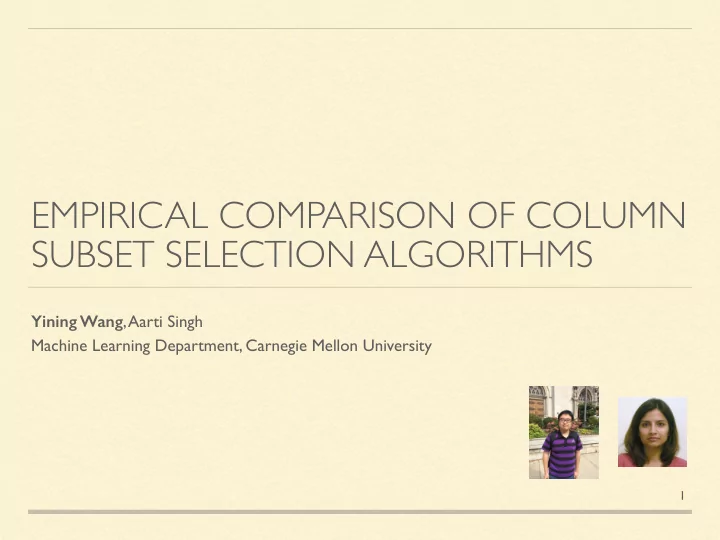

EMPIRICAL COMPARISON OF COLUMN SUBSET SELECTION ALGORITHMS Yining Wang , Aarti Singh Machine Learning Department, Carnegie Mellon University 1
COLUMN SUBSET SELECTION M ∈ R n 1 × n 2 C ∈ R n 1 × s | C | ≤ s k M � CC † M k F min 2
COLUMN SUBSET SELECTION Interpretable low-rank approximation (compared to PCA) Applications: Unsupervised feature selection Image compression Genetic analysis: target SNP selection, etc. Challenges: Exact column subset selection is NP-hard 3
ALGORITHMS Deterministic Algorithms Rank-revealing QR (RRQR) [Chan, 87] Most accurate, but expensive: O ( n 3 ) Sampling based algorithms,slightly inaccurate, but cheap: O ( n 2 k ) Norm sampling [Frieze et. al., 04] Leverage score sampling [Drineas et. al., 08] Iterative norm sampling (approximate volume sampling) [Deshpand & Vempala, 06] 4
NORM SAMPLING The algorithm: 1. Compute column norms k M ( i ) k 2 2. Sample each column with probability p i / k M ( i ) k 2 2 Time complexity: O ( n 2 ) “Additive error” Error analysis: k M � CC † M k 2 F k M � M k k 2 F + O ( k/s ) · k M k 2 F 5
LEVERAGE SCORE SAMPLING The algorithm: M = U k Σ k V > k + U � k Σ � k V > 1. Top-k truncated SVD: � k p i / k U k e i k 2 2. Leverage score sampling: 2 Time complexity: O ( n 2 k ) “Relative error” Error analysis: assuming s = Ω ( k 2 / ✏ 2 ) k M � CC † M k F (1 + ✏ ) k M � M k k F 6
ITERATIVE NORM SAMPLING Initialize C=0. Repeat until s columns are selected: r i = M ( i ) − CC † M ( i ) 1. Compute residue: p i / k r i k 2 2. Residue norm sampling: 2 Time complexity: O ( n 2 s ) “Multiplicative error” Error analysis: k M � CC † M k 2 ( k + 1)! k M � M k k 2 ⇥ ⇤ E c F F 7
QUESTION Three different algorithms Norm sampling: k M � CC † M k 2 F k M � M k k 2 F + ✏ k M k 2 F Leverage score sampling: k M � CC † M k 2 F (1 + ✏ ) k M � M k k 2 F Iterative norm sampling: k M � CC † M k 2 F ( k + 1)! k M � M k k 2 F Which one works best in practice? 8
EXPERIMENTS Synthetic data: Generate an n x k random Gaussian matrix A Set M = AA T , then normalize so that M has unit F norm Coherent design: pick a random column in M, enlarge its norm by 10 times and repeat the same column five times. Noise corruption: impose entrywise zero-mean noise on the normalized matrix M. 9
EXPERIMENTS Low-rank input, coherent design 10
EXPERIMENTS Full-rank input, coherent design 11
EXPERIMENTS Computational efficiency 12
EXPERIMENTS Human genetic data: Hapmap Phase II 13
CONCLUSION Iterative norm sampling performs much better than leverage score sampling in practice, which is not predicted by existing theoretical results. Iterative norm sampling is also computationally cheaper then leverage score sampling , which requires truncated SVD. Calls for improved analysis of iterative norm sampling! 14
REFERENCES T.F. Chan, “Rank Revealing QR Factorizations,” Linear Algebra and Its Applications, vol. 88, pp. 67-82, 1987. A. Frieze, R. Kannan and S. Vempala, “Fast Monte-Carlo Algorithms for Finding Low-rank Approximations,” Journal of the ACM , vol. 51, no. 6, pp. 1025-1041, 2004. P . Drineas, M.W. Mahoney and S. Muthukrishnan, “Relative-error CUR Matrix Decompositions,” SIAM Journal on Matrix Analysis and Applications , vol. 30, no. 2, pp. 844-881, 2008. A. Deshpande and S. Vempala, “Adaptive Sampling and Fast Low-rank Matrix Approximation,” in Approximation, Randomization, and Combinatorial Optimization. Algorithms and Techniques, 2006, pp. 292-303. 15
Recommend
More recommend